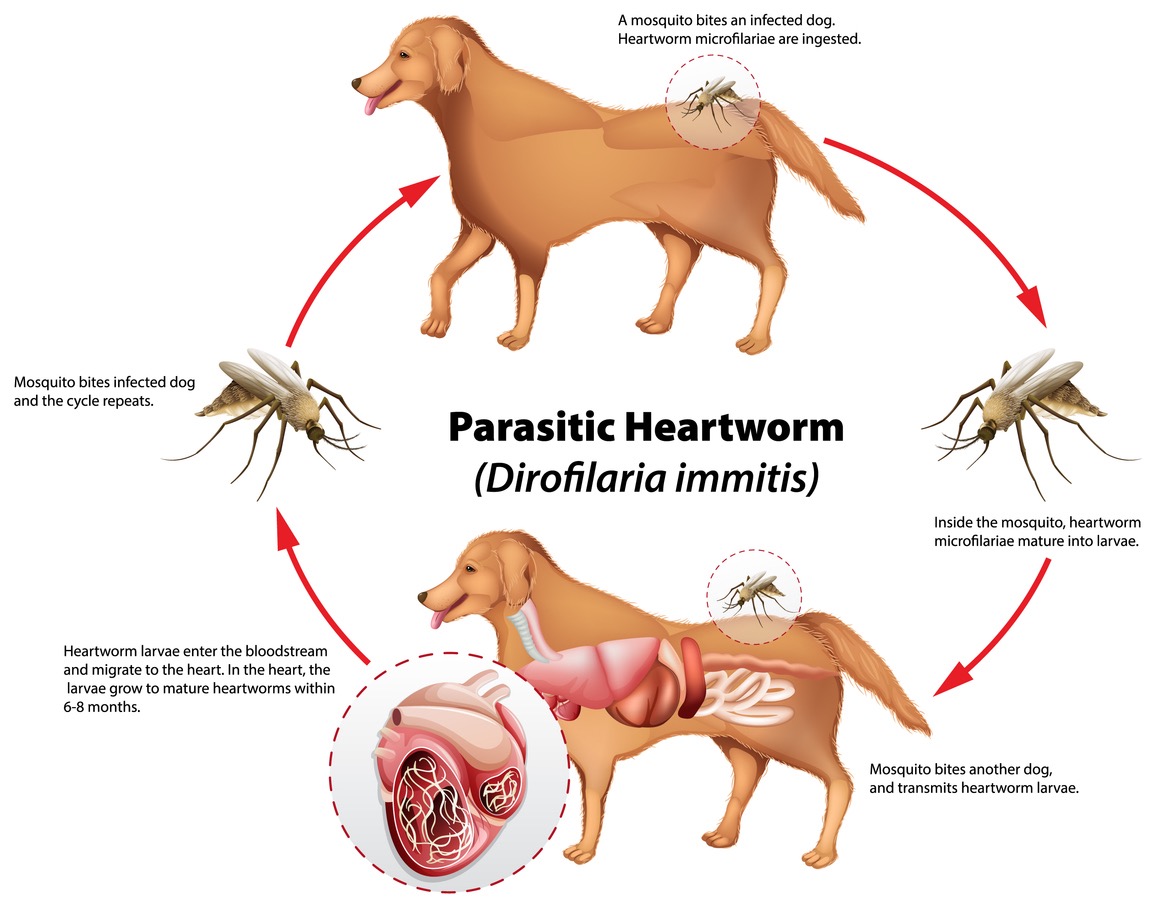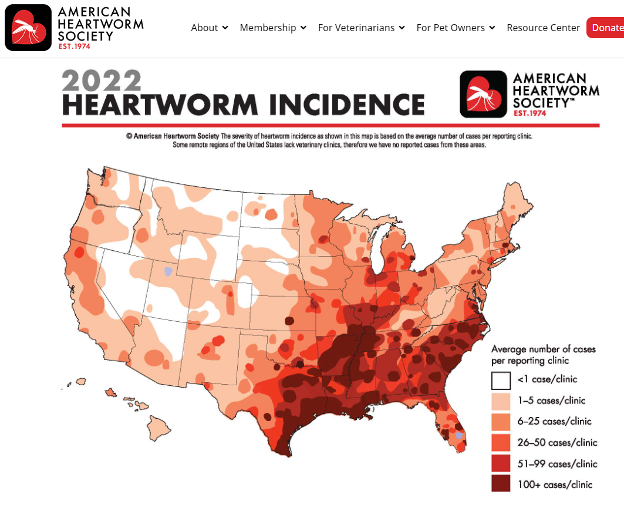As a dedicated veterinarian serving the Elmwood and Williamsfield communities in Illinois, I understand the importance of educating pet owners about prevalent health concerns affecting their beloved companions. Heartworm disease remains a significant threat to both dogs and cats in our region, posing severe risks to their well-being if left untreated. With a passion for preventative care and a commitment to providing comprehensive medical guidance, I aim to give pet owners the knowledge and resources to safeguard their furry friends against this potentially life-threatening condition.
What is Heartworm Disease?
Heartworm disease is a potentially life-threatening illness in pets caused by worms transmitted through mosquito bites, which can lead to serious health complications affecting the heart and lungs.
The life cycle of a heartworm involves five stages:

- Mosquito Infection: It starts when a female mosquito bites an infected animal (usually a dog or a wild animal like a coyote or fox) carrying microscopic baby heartworms, called microfilariae, in its blood.
- Development of Heartworms in the Mosquito: Inside the mosquito, these baby heartworms mature into larvae in about 10 to 14 days.
- Transmission: When the infected mosquito bites another animal, it injects these larvae into its bloodstream.
- Migration to Heart and Lungs: The larvae travel through the infected animal’s bloodstream until they reach the heart and lungs. There, they grow into adult worms over several months. The worms can grow up to a foot long and take residence in the heart and lungs of dogs or cats.
- Mating and Production of Microfilariae: Once matured, the adult worms mate and produce microfilariae, which circulate in the infected animal’s bloodstream, completing the cycle.
Common Misconceptions About Heartworm Disease
There are misconceptions surrounding heartworm disease that can lead to complacency and put pets at risk.
- One common misconception is that indoor pets are not susceptible to heartworm infection. However, mosquitoes can still find their way indoors. Besides, all it takes is one bite to transmit the disease.
- Another misconception is that heartworm disease only affects dogs. While dogs are more commonly affected, cats and ferrets can contract heartworm disease, and the consequences can be just as severe.
Symptoms and Signs of Heartworm Disease in Pets
The symptoms of heartworm disease can vary depending on the infection’s severity and the animal’s species. In the early stages, pets may exhibit subtle signs such as a mild cough or fatigue. This disease is often referred to as the “silent killer” because, in its early stages, it usually shows no symptoms or only very subtle ones. Dogs and cats infected with heartworms may not exhibit any signs until the disease has progressed to a more advanced stage. Significant damage may have already occurred to the heart, lungs, and other organs by this time.
Below are the symptoms the American Heartworm Society lists for dogs and cats.
Dogs:
- Mild, persistent coughing
- Reluctance to exercise
- Fatigue after moderate activity
- Decreased appetite
- Weight loss
As heartworm disease progresses, pets may develop heart failure and the appearance of a swollen belly due to excess fluid in the abdomen.
Cats:
Signs of heartworm disease in cats can be very subtle or very dramatic. Symptoms may include:
- Coughing
- Asthma-like attacks
- Periodic vomiting
- Lack of appetite or weight loss.
- Occasionally, an affected cat may have difficulty walking, experience fainting or seizures, or suffer from fluid accumulation in the abdomen.
Sadly, the first sign in some cases, is the cat’s sudden collapse or death.
Diagnosis and Testing for Heartworm Disease
Early detection of heartworm disease is crucial for successful treatment and prevention of further complications. We typically perform a series of tests to diagnose heartworm disease, including a blood test that detects the presence of adult heartworms or their offspring. Imaging techniques like X-rays or ultrasounds can tell us the extent of the infection.
While infected dogs may have 30 or more worms in their heart and lungs, cats usually have 6 or fewer—and may have just one or two. But while the severity of heartworm disease in dogs is related to the number of worm, in cats, just one or two worms can make a cat very ill. Diagnosis for cats can be complicated, requiring a physical exam, an X-ray, a complete blood count and several kinds of blood test. We may also recommend an ultrasound.
Treatment Options for Heartworm Disease
Treating heartworm disease in dogs can be complex and lengthy, especially in advanced cases. The goal of treatment is to eliminate adult worms and prevent further damage to the heart and lungs. Treatment typically involves a combination of medication, rest, and close monitoring. In severe cases, surgery may be necessary to remove the worms from the heart and blood vessels.
Unfortunately, there is no approved drug therapy for heartworm infection in cats. The drug used to treat infections in dogs is not safe for cats. Nevertheless, we can often help cats with heartworm disease with good veterinary care. The goal is to stabilize your cat and determine a long-term management plan.
Heartworm in Illinois

The AHS conducts a heartworm incidence survey every three years, working with veterinary practices and shelters that submit data from heartworm antigen tests conducted during the previous year. The latest survey was conducted in early 2023 and reflects data from testing conducted during 2022.
In Illinois, the presence of mosquitoes throughout the spring, summer, and early fall means there is a greater chance that your pet can contract heartworms. However, a pet can get heartworms at any time of the year. For this reason, year-round preventative measures are crucial to protect pets.
Prevention and Proactive Measures Against Heartworm Disease
Prevention is always better than cure for heartworm disease in dogs and cats. Several options for preventing heartworm infection are available, including monthly preventive medication and yearly testing. I can recommend the most suitable preventive measures based on your pet’s lifestyle, risk factors, and overall health. Following the prescribed preventive regimen is essential to protect your pet consistently.
The Importance of Regular Veterinary Check-Ups
Regular veterinary check-ups are essential for maintaining your pet’s overall health and well-being, including protection against heartworm disease. During these visits, I can perform routine screenings for heartworm infection, assess your pet’s overall health, and provide guidance on preventive measures. I can address any concerns or questions regarding heartworm disease or other potential health issues.
Empowering Pet Owners: A Proactive Approach to Heartworm Prevention and Care
In conclusion, safeguarding pets against heartworm disease requires a proactive approach. Through regular veterinary check-ups and the consistent administration of preventive measures, such as monthly medications and yearly testing, we can collectively combat the threat of heartworm disease and ensure your beloved pets’ long-term health and happiness. As your dedicated veterinarian, I am committed to partnering with you in this endeavor, offering comprehensive medical guidance and support every step of the way. Let’s work together to reduce the risks of heartworm and keep your pets healthy. Contact us today!
Warm Regards,
Dr. Janelle McFarland & Team
